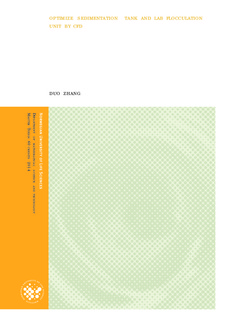| dc.description.abstract | This work aim at introduce basic knowledge of CFD and it’s application in optimization of sedimentation tank and lab flocculation units. A series of specialized strategies are developed for the simulation of the sedimentation tanks and lab flocculation units. Chapter 1 is general introduction of particle removal in water and wastewater treatment, includes particle separation, as well as particle removal during chemical treatment and biological treatment.
In chapter 2, background and application of CFD is introduced, development of CFD, application of CFD in different water and wastewater treatment processes are illustrated, the advantage of introduce CFD into water and wastewater treatment processes optimize and design then apparent.
Governing equations and basic numerical solution procedure of CFD are introduced in chapter 3, a compact direct numerical solution of Navier-stokes equation is demonstrated in this chapter, the demonstration could help readers gain quickly understanding about some basic concepts of CFD. Some concepts used in commercial CFD software, such as pressure-velocity coupling, residual, convergence criteria and under relaxation factor, also briefly explained, these concepts will be used in following chapters.
The major content of chapter 4 is turbulence model, because most flows in reality are turbulence flow, to ensure accuracy of CFD simulation, turbulence model is necessary, an appropriate turbulence model in addition to governing equations is prerequisite of acceptable CFD simulation, main stream turbulence model, includes zero equation model, one equation model, two equations k-εmodel, two equations k-ωmodel, seven equations Reynolds stress model as well as large eddy simulation, is introduced in this chapter.
Chapter 5 introduce the species transport and reaction model, Residence Time Distributed (RTD) is a very important parameter in reactor design, in commercial CFD software, RTD can be obtained by solve the species transport and reaction model with assistance of continuity equation, Navier-stokes equation and turbulence models.
Chapter 6 mainly focus on different multi-phase models available in current commercial CFD software, because most flows in reality consist of more than one phase, in order to increase accuracy of CFD simulation, also modeling multi-phase phenomena, different multi-phase models are coupled into commercial CFD software, multi-phase models should be selected carefully according to characteristic of phases in flow, another factor need taken into consideration when choosing a multi-phase model is computer power, since multi-phase models require higher CPU usage compare to single phase simulation. The major task of chapter 6 is introduce different multi-phase models and explain why Mixture model is selected as multi-phase model used in this study.
Chapter 7 demonstrate and analyze single phase and RTD simulation result for seven different sedimentation tank models, contour of velocity gradient, velocity vector, kinetic energy and RTD curve for different designs is demonstrated. According to simulation result, several failures such as strong surface current and re-circulating current is detected in the original design, the hydraulic performance is improved in modified designs.
Chapter 8 demonstrate and analyze the multi-phase simulation result, the multi-phase simulation in this chapter use transient solver, so that simulation result at different simulate times are recorded, “density current” is detected in the multi-phase simulation result, through analyze distribution of sediments, the function of sludge hopper and stability of sludge layer is studied.
Chapter 9 demonstrate and analyze simulation result for one Flat Blade Turbine (FBT) and two Pitched Blade Turbines (PBT) with different inclined angles, a special mesh generation technique, namely “Multi Reference Frame (MRF)”, also illustrate in this chapter, the mixing effect of different mixing devices is demonstrated through display contour of velocity gradient and velocity vector. | nb_NO |
